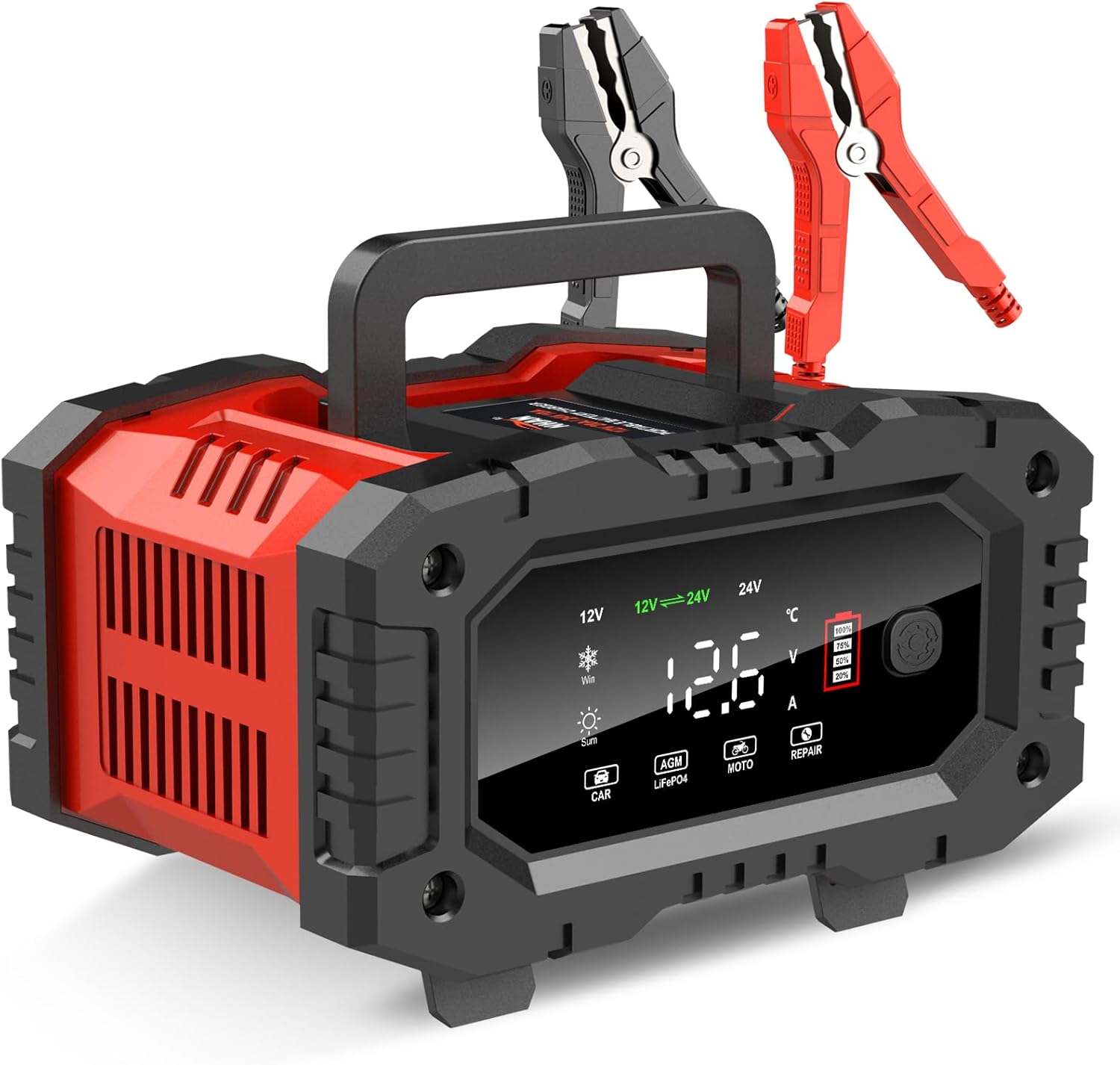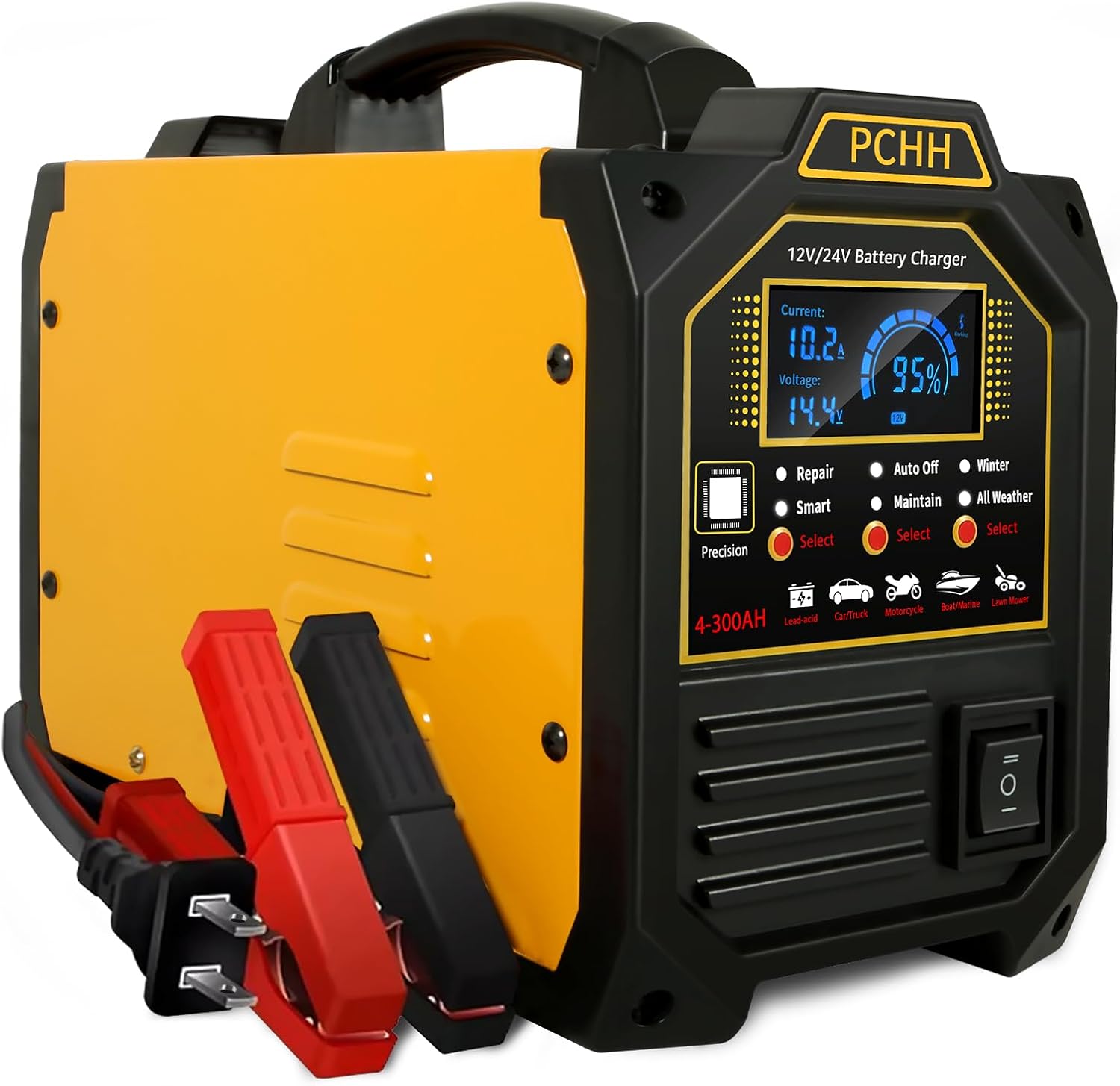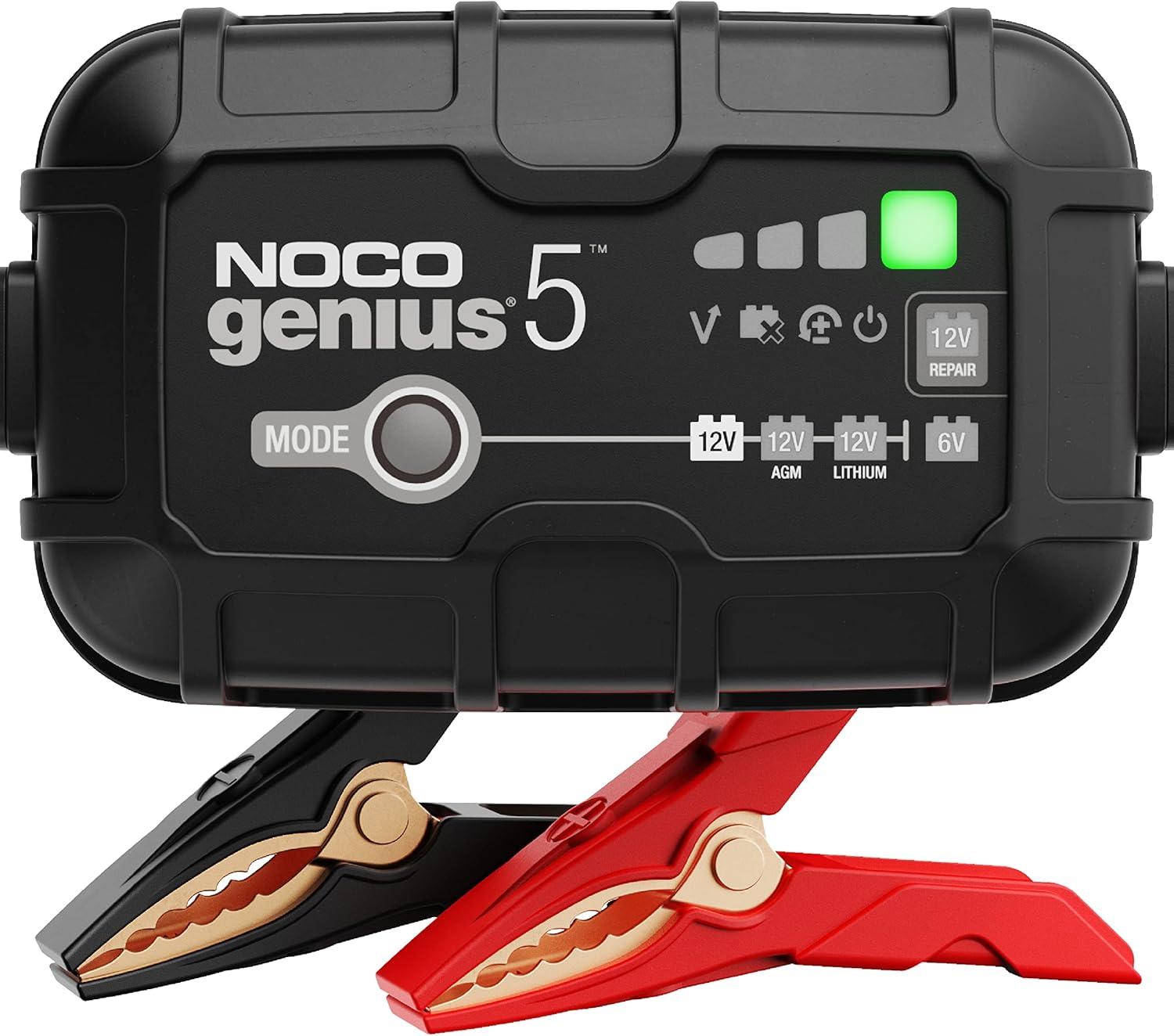Here’s an overview of the Best Car Battery that we’ll explore today:
Car battery chargers are essential tools for preserving battery life, preventing stranded starts, and maintaining optimal performance across seasonal cycles. The category has evolved from basic trickle chargers to smart, multi-mode devices that diagnose, repair, and desulfate. In this review, I tested and compared five widely available models that span a price spectrum from budget to premium, across three brands (YONHAN, NOCO, PCHH). My methodology combines practical lab-style evaluation with real-world usability: I assess charging speed, accuracy of indication, temperature compensation, repair/rehabilitation modes, safety protections, build quality, and how well the device communicates status to the user via displays or indicators. I also weigh long-term value, including warranty, supported battery chemistries, and suitability for 12V vs 24V systems as well as LiFePO4 compatibility where applicable.
1. YONHAN Battery Charger 10-Amp 12V
- Brand: YONHAN
- Manufacturer: YONHAN
Overview: This compact 10-Amp smart charger functions as a charger, maintainer, trickle charger, and desulfator for 12V and 24V lead-acid batteries with temperature compensation and a backlit LCD. It supports AGM, GEL, SLA, and Flooded chemistries and includes winter/summer modes, reverse polarity protection, overcharge protection, and short circuit prevention. Notable is its desulfation capability and the memory of the last mode after outages, which enhances convenience for seasonal storage and long idle periods.
Performance-wise, the unit offers practical mid-range charging with a clear display showing voltage, current, power percentage, temperature, and mode. Its thermal sensor helps prevent overcharging in heat and undercharging in cold, but its 10A rating means longer charging times for large or deeply discharged batteries. The desulfator feature is beneficial for aging batteries but should not be relied on for completely dead or lithium-based packs. The included lead lengths (90 cm input, 65 cm output) are adequate for most installed setups. Overall usability is strong for everyday cars, motorcycles, and small boats, with the safety features providing peace of mind for amateur installers.
Pros
- All-in-one solution: charger, maintainer, trickle charger, desulfator
- Temperature-compensated charging with winter/summer modes
- Backlit LCD with multiple parameters (voltage, current, temperature, mode)
- Desulfation/repair mode to revive aging batteries
- Memory of last mode after power outage
Cons
- 10A limit may be slow for large 12V/24V batteries
- Desulfation not effective on completely dead or damaged cells
- Not compatible with lithium batteries
2. YONHAN Battery Charger 20A 12V/24V LiFePO4 Lead Acid Fully Automatic Battery Maintainer
- Brand: YONHAN
- Manufacturer: YONHAN
Overview: This higher-capacity YONHAN charger provides 20A (12V) / 10A (24V) capability with LiFePO4 compatibility, supporting AGM, GEL, EFB, SLA, Flooded, and other lead-acid chemistries. It’s designed for faster charging, with a 3-in-1 quick battery charger approach, automatic mode switching, a built-in repair function, and an extra-large LCD. It targets larger vehicles or deep-cycle applications and emphasizes robust protections including cooling, overcurrent, reverse polarity, short circuit protection, and temperature-aware control.
In practice, the 20A option speeds up recovery and charging on larger batteries and those with higher reserve capacities. The unit automatically enters trickle/float after charging, which is essential for maintaining batteries during long absences (winter storage). The repair mode leverages pulse technology to recover idle or aging batteries, but like most desulfation methods, it cannot resurrect severely damaged cells or batteries below 0.3V. The screen is bright and legible, aiding visibility in bright sunlight. The device is heavier (approximately 2.68 lb) and larger than the 10A model, reflecting its higher power and cooling requirements.
Pros
- Higher charging power (20A) for faster top-ups
- LiFePO4 and broad lead-acid compatibility
- Brighter, informative LCD display
- Effective auto-maintain and trickle modes
- Recovery/repair mode with pulse technology
Cons
- Heavier and larger footprint
- Not a jump-starter; still requires outlet power
- Repair mode cannot fix totally dead cells
3. NOCO GENIUS1: 1A 6V/12V Smart Battery Charger – Automatic Maintainer
- Brand: NOCO
- Manufacturer: NOCO
Overview: NOCO’s GENIUS1 is a tiny but capable 1A charger designed for 6V and 12V lead-acid and LiFePO4 batteries. It combines charging, maintenance, trickle, and desulfation with an integrated thermal sensor for temperature compensation and a Force Mode to recover deeply discharged batteries. Its compact footprint (3.5 x 2.3 x 1.3 inches) makes it ideal for tight spaces and emergency kits. The package includes a wall plug, DC cable with clamps, and eyelet terminals, with a durable USA design ethos and a 3-year warranty.
Performance-wise, GENIUS1 shines in ease of use and versatility for small batteries and maintenance tasks. The ability to charge as low as 1V and Force Mode to revive near-dead batteries is beneficial for neglected packs, though it’s not intended for high-current top-ups. The device maintains safely over time, preventing overcharging and supporting a wide range of vehicles from motorcycles to classic cars. Users appreciate the compact size, clarity of status indicators, and the broad compatibility spectrum, though some may prefer higher amperage for faster service on larger batteries.
Pros
- Very compact and portable
- Supports 6V and 12V lead-acid and LiFePO4
- Force Mode for deeply discharged batteries
- Temperature compensation for safe charging
- 3-year warranty and USA design
Cons
- Only 1A output limits speed on larger batteries
- No 24V support
- Not a replacement for high-capacity jump starts
4. 12V 24V Car Battery Charger Heavy Duty
- Brand: PCHH
- Manufacturer: PCHH
Overview: A premium heavy-duty charger from PCHH with 12V/24V auto-detection and 0-15A adjustable charging, designed for a wide range of lead-acid chemistries including AGM, GEL, and deep-cycle variants. It emphasizes a rugged build (copper coil, metal/ABS case) and an LCD display for real-time data. Features include a dead-battery repair mode, auto-off maintain mode, winter mode, and a stable 12V DC power supply for ancillary uses. A 3-year warranty supports reliability for frequent use in garages, fleets, or workshops.
Performance-wise, the charger offers true adjustable amperage to tailor the charge rate to battery size and application, with an emphasis on safety via multiple protections (reverse polarity, short circuit, overcharge, overheat, over-voltage, over-current). The maintain mode with a pulse current can extend life for sulfated or stratified batteries after initial charging. However, its 12V/24V auto-detection implies users should still verify battery type and voltage to avoid mismatches. The unit’s weight (~12.2 lb) and larger footprint reflect its industrial-targeted design, which can be a drawback for tight garages but a boon for heavy-duty usage.
Pros
- Broad compatibility with many lead-acid chemistries
- 0-15A adjustable charging for flexibility
- Winter mode and auto-maintain with pulse current
- Rugged build and clear LCD readouts
- 3-year warranty and robust protections
Cons
- Heavy and bulky for small workshops or home garages
- Not LiFePO4 compatibility mentioned
- Higher price may be overkill for casual users
5. NOCO GENIUS5: 5A 6V/12V Smart Battery Charger – Automatic Maintainer
- Brand: NOCO
- Manufacturer: NOCO
Overview: NOCO’s GENIUS5 delivers 5A of charging for 6V/12V systems, offering the same all-in-one capabilities as the GENIUS1 and GENIUS5’s larger siblings: charging, maintenance, trickle, desulfation, and temperature-compensated control. It comes with a long cable, mounting hardware, and a 3-year warranty. The description emphasizes a compact yet capable design suitable for mid-range to larger lead-acid and LiFePO4 batteries.
Performance-wise, GENIUS5 provides a balance of speed and finesse, enabling quicker top-ups than GENIUS1 while maintaining safety and sulfation reversal. The Force Mode and thermal sensor provide resilience for neglected packs, and its compatibility with LiFePO4 expands its utility beyond just lead-acid. The unit remains portable, with a footprint similar to the GENIUS1 but with more amperage than the 1A model, making it versatile for hobbyist garages and everyday maintenance tasks. As with other NOCO models, the user experience benefits from clear indicators and a strong warranty.
Pros
- Moderate 5A output suitable for mid-sized batteries
- Supports 6V and 12V with LiFePO4 compatibility
- Force Mode for difficult batteries and long-term maintenance
- Temperature compensation for safe charging
- Mounting hardware and long cables included
Cons
- Limited to 5A; slower for larger batteries
- No 24V support
- Premium price relative to feature set
Frequently Asked Questions
We’ve compiled answers to the most common questions about car batterys to help you make an informed decision.
Conclusion
Final thoughts: For casual users, NOCO GENIUS1 and YONHAN 10A provide the best balance of price, features, and ease of use.
For owners with larger or multiple batteries, the YONHAN 20A offers faster charging and LiFePO4 support. In professional or heavy-duty environments, the PCHH heavy-duty charger delivers rugged reliability with comprehensive protections.
The GENIUS5 sits between, offering greater output than the 1A model with LiFePO4 compatibility and enhanced features. Your choice should align with battery size, chemistry, climate, and how hands-on you want to be with maintenance and rehabilitation tasks..




